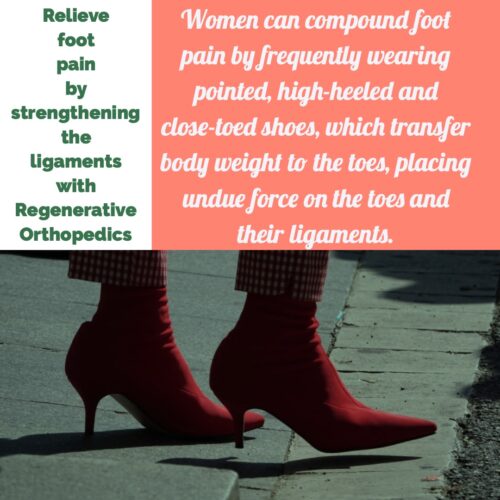
Do you wear pointy, closed-toed shoes?
Persistent foot and toe pain affects an incredibly large part of our population. And it’s no wonder. We spend hours on our feet every day, working, playing, and engaging in everyday activities. Some of us pound our feet running marathons, while others try to reach that goal of 10,000 steps a day. Each of those steps generates a force on the foot.
Add to that, activities like jumping and running, and the force we place on our feet increases that much more. During an average day, the feet support a combined force equivalent to several hundred tons. It is not surprising, then, that the majority of us experience foot pain at some point in our lives.
We can compound our problems of foot pain by our choices of footwear. Improper foot mechanics with walking, running and intense training can cause problems with our feet too. Various physical conditions such as high arches, fallen arches, degenerative arthritis, bony abnormalities, flat-footedness, inflammatory joint diseases and excess weight also predispose us to foot pain.
The foot, if we include the toes and ankle, contains 26 bones. That’s a lot of bones. Plus, all of those bones make up 33 joints supported by more than 100 muscles, tendons and ligaments. Any of these structures can become weakened or injured. And that means a whole lot of different structures can get injured. Those injuries destabilize the foot, because they cause insufficient ligament and tendon support for proper motion in the joints. The result is foot pain due to the joints of the foot becoming weak, lax, and unstable.
Instability in any joint typically begins with an injury to the ligaments and tendons that support the joint. Because the joint is no longer held in place by healthy ligaments and tendons, abnormal joint motion develops. This abnormality in the movement of the joint results in a greater amount of pressure being exerted on the different parts of the joint.
All of the structures of the joint can become damaged. Even the cartilage. When cartilage degenerates, the joint will crunch and grind. As time passes, the body reacts to this instability by contracting the muscles in the area. You will experience that as muscle spasms.
Eventually, these tense muscles fatigue and lose their strength. Then the ligaments and tendons will try even harder to stabilize the joints. But they will become damaged further. That is the cycle of abnormal joint motion. And it results in degeneration of the joint. The body responds to the failure of these various soft tissue structures by increasing bone mass in an attempt to stabilize the joint. In other words, arthritis will develop. And arthritis is a frequent diagnosis related to foot pain.
Instability of the joints of the foot can also result in a number of toe and forefoot conditions. These include Morton’s Neuroma, bunions (hallux valgus), and a stiff, degenerated, big toe called hallus rigidis. The origin of these conditions can be traced back to an original ligament injury or weakness.
Morton’s Neuroma refers to a fibrous tissue formation around nerve tissue in the spaces between the toes. It results in symptoms like sharp pains, burning sensations, and paresthesias (abnormal sensations).
This condition is not traditionally thought of as being an instability problem. However, injury to ligaments of the foot can cause excessive motion between the bones of the toes, causing irritation of the bursa or a nerve, and can result in a significant enlargement of the nerve. This enlargement can cause further trauma and worsening of the symptoms. And they can be quite severe.
Morton’s Neuroma most often affects women who frequently wear pointed, high-heeled and close-toed shoes, the mechanics of which transfer body weight to the toes, placing undo force on the toes and their ligaments.
Bunions are another widespread, persistent foot complaint, also commonly seen in women. This growth in boney tissue occurs mainly on the medial side of the foot, producing the characteristic bump or bunion. Joint instability here causes the bones of the toes to move in an abnormal fashion. This shift leads to the formation of the boney projection on the medial side of the toe in an attempt to stabilize joint motion.
Hallux rigidus is a disorder of the joint at the base of the big toe, which causes pain and stiffness in the toe. Over time, the toe becomes increasingly more difficult to bend.
Hallux refers to the big toe. And rigidus means the toe is rigid. The condition is caused by degenerating cartilage in the metatarsophalangeal (MTP) joint of the big toe. Eventually, it will lead to the formation of bone spurs around the joint—a last ditch effort of the body to stabilize the joint.
The underlying condition of both bunions and hallux rigidus is instability that causes arthritis of the MTP joint.
Abnormal joint shifts are what precipitate the pathological bone growth associated with bunions, reducing movement in both flexion and extension, and leading to hallux rigidus and to a potentially frozen joint.
Standard treatment for foot pain is generally conservative, beginning with choosing properly fitting shoes. NSAIDs are often prescribed, along with physical therapy. When foot and toe pain continue, surgery is frequently considered. In fact, surgery on the first metatarsophalangeal joint is one of the most common surgery performed.

Regenerative Orthopedics instead of Surgery for foot and toe pain!
Despite the commonality of these treatments, a large percentage of people continue to suffer with foot and toe pain. An effective alternative treatment for reduction and elimination of this pain is Regenerative Orthopedics, because it addresses the underlying cause of the problem, the joint instability caused by ligament and tendon injury.
By strengthening ligaments and tendons, Regenerative Orthopedics can stop the pathologic cascade causing these persistent foot conditions, stabilizing the joint and bringing pain relief.